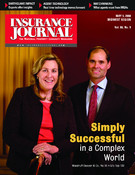Weeks after a 5.2 level earthquake rocked the Midwest from Cairo, Ill., to Atlanta, Ga., geologists and the insurance industry are still discussing the impact of the quake — such as increases in the purchase of earthquake insurance.
Earthquake endorsement
State Farm insurance spokeswoman Missy Lundberg said that although she can’t provide exact numbers, there has been a huge increase by policyholders opting to add the earthquake endorsement, particularly in Southern Illinois. Lundberg was careful to explain who is covered immediately and who is not.
“Policyholders who live less than 100 miles from the epicenter of the quake must wait 30 days before the coverage is there,” she said. “Of course if you are outside the 100 mile limit, coverage is immediate.”
In South Bend, Ind., the 1st Source Insurance Agency’s Risk Manager Lee Hoffman said his agency has not had one phone call inquiring about an earthquake insurance endorsement.
“We are quite a bit north of the epicenter, but I was awakened during the night,” he said. “Why we haven’t had more requests for coverage I can’t say.”
With some policyholders quickly buying coverage and others dismissing the need, it raises the question about the probability of another quake hitting Illinois any time soon.
Probability
Russ Wheeler, a research geologist with the United States Geological Survey (USGS) said that there is no way to predict the probability of another quake hitting at any specific time.
“There are no hard and fast instruments or scientific ways of determining that kind of probability,” Wheeler said. However, he did say that although this earthquake was sizable, the quakes that shook the Midwest in 1811 and 1812 were probably 8 on the Richtor scale and explained that the devastation could have been worse if the area had been more populated.
In the scientific community some say earthquakes hit the Midwest each year and this group is willing to make predictions.
Illinois experiences one earthquake annually says USGS, one of the nation’s leading authority on earthquakes. The last quake to cause damage measured 5.0 in magnitude and occurred near Lawrenceville and Olney in 1987 and was felt as far north as Chicago..
USGS seismologists estimate chances that a quake measuring 6.3 or greater will strike the Midwest in the next 15 years at 40 percent to 63 percent. That likelihood jumps to 100 percent in the next 50 years.
Aftershocks continue
Even two weeks after the event aftershocks, some sizable, continued to be felt in Illinois and Indiana. According to an Associated Press account a 3.7 magnitude temblor was felt in Evansville on April 25, 2008, as geologists from nine states met in the southwestern Indiana city to discuss the recent quakes.
“We will probably be seeing these for weeks,” said Bob Bauer of the Illinois State Geological Survey.
The U.S. Geological Survey says 26 aftershocks have been centered in Illinois since a 5.2-magnitude quake centered in an area below West Salem, Ill., caused minor damage. Two of the aftershocks have measured at least a 4.0 magnitude, but most have been about 2.0.
The epicenter of the April 25 aftershock was below Bellmont, Ill., about 35 miles from Evansville, Ind. There were no reports of damage or injuries, but some Evansville residents felt it.
The geologists said such quakes may unsettle the public but they help geologists better understand the Wabash Valley Seismic Zone, of which relatively little is known.
Construction Issues
What if a sizable earthquake hit the Midwest in the next 5 or 10 years? Would buildings be able to withstand the quake as many do in the West coast where there are building codes?
Keith Lessner, vice president of loss control for the Property Casualty Insurers Association of America (PCI) said that the Illinois earthquake provides an excellent opportunity to create greater awareness of the need for appropriate building codes throughout the United States and in particular in the Midwest.
“In the last few years most attention related to building codes has focused on wind damage in hurricane prone areas,” Lessner said. “But regardless of the peril, building codes can play an important role in saving lives and reducing property losses. Retrofitting homes and businesses to meet current codes can also provide an extra measure of safety and security from the potential of natural disaster.”
Lessner added that while many states in the Midwest that would be affected by activity in the New Madrid and Wabash Valley seismic zones do not have statewide building codes, they all have codes that regulate some aspects of building. At a minimum the PCI would like to see communities that are in areas of highest risk take steps to strengthen their building codes to minimize the potential for loss. Additionally, it is important for residents and businesses to take precautionary steps to secure their property from earthquake damage. This is a wake up call that we hope will not be ignored, Lessner said.
Justin Roth, senior director of public affairs for the National Association of Mutual Insurance Companies (NAMIC), agrees and said that NAMIC, PCI and other national groups have formed the “Building Code Coalition” with the goal of encouraging all states to adopt statewide building codes.
“Missouri and Illinois do not have statewide codes and should have them,” Roth said. “A recent study told us that if Louisiana had building codes at the time Katrina hit up to 80 percent of insurance losses could have been avoided.”
Roth said the Coalition is pushing for bigger federal incentives for extra dollars for states that adopt statewide building codes, bumping up the percentage of monies states would receive by 4 percent if they enact the codes.
Topics Catastrophe Natural Disasters USA Illinois Construction Earthquake
Was this article valuable?
Here are more articles you may enjoy.


 US Property Insurance Rates Fall for First Time Since 2017
US Property Insurance Rates Fall for First Time Since 2017  US Nuclear Verdicts Break Records and Drive Social Inflation to 7% in 2023: Report
US Nuclear Verdicts Break Records and Drive Social Inflation to 7% in 2023: Report  Former UPS Driver Wins $238 Million Verdict in Suit Over Firing
Former UPS Driver Wins $238 Million Verdict in Suit Over Firing  Mutual Insurers Chase Rate Adequacy, Financial Strength Remains Strong: AM Best
Mutual Insurers Chase Rate Adequacy, Financial Strength Remains Strong: AM Best 


